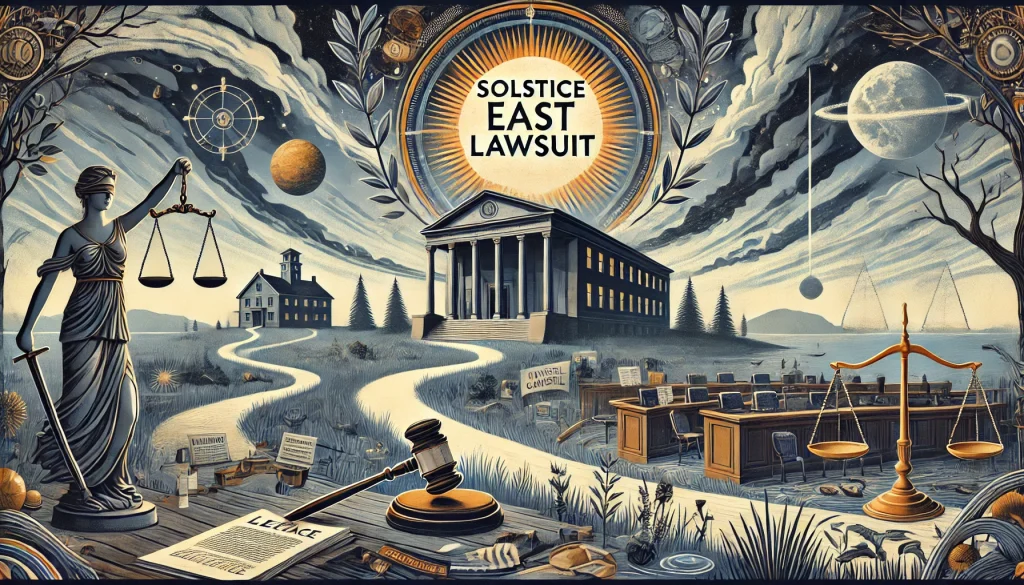The Solstice East lawsuit has captured significant attention due to allegations surrounding the practices of the residential treatment center. Solstice East, known for providing care to adolescents struggling with mental health issues, has faced scrutiny regarding its operational standards and treatment methods.
This lawsuit highlights concerns raised by former residents and their families, shedding light on accusations of negligence, improper care, and other legal issues. The claims have sparked debates about the transparency and accountability of such institutions.
The Solstice East lawsuit not only underscores the challenges faced in the troubled teen industry but also raises questions about regulatory oversight. As legal proceedings unfold, it has become a focal point for advocates calling for reform in adolescent care facilities.
Background of Solstice East and Its Services
Solstice East is a residential treatment center located in North Carolina, primarily designed to serve adolescent girls with emotional, behavioral, and mental health challenges. The facility offers specialized care in a structured environment, focusing on therapeutic interventions to promote emotional well-being and personal growth.
The center emphasizes holistic approaches, incorporating equine therapy, group counseling, and individual sessions. Its secluded location in the Blue Ridge Mountains aims to provide a tranquil setting conducive to healing.
Despite its advertised benefits, questions have been raised about the effectiveness of its programs. Former residents and families have expressed mixed reviews, with some praising the support staff while others allege substandard care.
Solstice East also claims to integrate academics into its therapeutic model, offering education alongside treatment. The curriculum aims to help residents stay on track academically while addressing their emotional needs. However, such claims are now under scrutiny following the allegations tied to the Solstice East lawsuit.
This lawsuit has cast a shadow over the center’s reputation, prompting broader discussions about accountability in the troubled teen industry.
Understanding the Solstice East Lawsuit: Reflections from Experts and Affected Families
The Solstice East lawsuit has become a critical reference point in discussions about the standards and practices in residential treatment facilities. Experts and families impacted by the case have spoken out, offering insights into the challenges these lawsuits present. As one legal advocate observed,
“Cases like the Solstice East lawsuit reveal the vulnerabilities within the troubled teen industry and the necessity for stringent safeguards to protect those most at risk.”
Former residents and their families have also shared their perspectives, shedding light on the emotional toll and sense of betrayal they felt. A parent involved in the lawsuit remarked,
“We entrusted Solstice East with our child’s care, hoping for healing, but instead, we faced broken promises and deeper wounds. This lawsuit is about ensuring no other family experiences this pain.”
Legal professionals involved in the Solstice East lawsuit have highlighted the complexities of such cases, emphasizing the need for thorough documentation and advocacy. One attorney noted,
“This isn’t just about one facility; it’s about holding an entire industry accountable. The stakes are high because the lives and futures of vulnerable adolescents hang in the balance.”
These reflections underscore the broader implications of the lawsuit, urging for reforms that prioritize transparency, ethical care, and accountability within residential treatment centers.
Claims of Medical Malpractice and Overmedication
One of the central issues in the Solstice East lawsuit involves accusations of medical malpractice and overmedication. Families allege that the facility relied heavily on pharmaceuticals without proper diagnoses or monitoring.

According to complaints, some residents were prescribed psychotropic medications shortly after their arrival, with little consideration for alternative treatments. Critics argue that this approach prioritized convenience over the long-term well-being of the teens.
Reports suggest that improper dosages or combinations of medications may have led to adverse side effects, including severe mood swings and physical health complications. In some cases, parents allege that medication changes were made without their knowledge or consent.
Additionally, concerns were raised about the lack of adequate medical personnel on-site to monitor the effects of such treatments. This issue is a recurring theme in the Solstice East lawsuit, as families claim that their children were left vulnerable to harm.
These allegations have drawn attention to the broader issue of overmedication in residential care settings. The lawsuit has become a rallying point for advocates seeking stricter guidelines on the use of medications in therapeutic programs for adolescents.
Initial Allegations Leading to the Solstice East Lawsuit
The Solstice East lawsuit stems from a series of allegations made by former residents and their families. These complaints primarily focus on claims of mistreatment, lack of oversight, and inadequate therapeutic practices.
Key allegations include emotional neglect, inappropriate disciplinary measures, and failure to properly assess the needs of individual residents. Some families claim that the facility overstepped boundaries, leading to further emotional harm rather than healing.
Concerns were also raised about the qualifications of the staff members responsible for providing care. Critics have pointed out that underqualified individuals were assigned critical therapeutic roles, potentially endangering the well-being of vulnerable teens.
A timeline of complaints suggests that these issues may have persisted for years, with red flags reportedly ignored. The Solstice East lawsuit has brought these concerns to the forefront, intensifying calls for investigations into the facility’s operational practices.
Additionally, advocacy groups for teens in residential care have highlighted systemic issues in facilities like Solstice East, where profit motives might overshadow genuine care. These concerns emphasize the need for reform to prevent future allegations.
Details of the Goss v. Solstice East Case
The Goss v. Solstice East case, at the center of the Solstice East lawsuit, outlines a series of specific allegations against the facility. This case gained traction due to its detailed claims, including accusations of neglect and improper treatment of residents.
The plaintiffs allege that their child suffered emotional and physical distress during their stay at Solstice East. Among the claims are inadequate supervision, forced isolation, and improper use of therapeutic techniques. The lawsuit also questions Solstice East’s transparency in its dealings with families.
Summary of Key Allegations in the Case:
- Lack of proper medical attention: Delayed responses to medical needs were a major concern.
- Isolation practices: Use of seclusion as a disciplinary tactic.
- Emotional harm: Residents claim they experienced more harm than healing during their stay.
|
Category |
Allegations |
Reported Impact |
|
Medical Care |
Delayed or improper treatment |
Worsening of existing conditions |
|
Disciplinary Practices |
Overuse of isolation |
Emotional trauma, loss of trust |
|
Therapeutic Effectiveness |
Unqualified staff |
Lack of progress, increased distress |
The case has prompted further investigations into similar facilities, as families demand greater oversight and transparency. The Solstice East lawsuit continues to influence discussions on accountability in the adolescent care industry.
Legal Proceedings and Court Rulings in the Solstice East Lawsuit
The Solstice East lawsuit has progressed through various stages of legal proceedings, capturing attention for its implications on the troubled teen industry. The case began when families of former residents filed complaints alleging misconduct and negligence at the facility.
During the initial hearings, the plaintiffs presented evidence of emotional and physical harm suffered by the residents. Testimonies included personal accounts of neglect, improper medical treatment, and alleged mistreatment by staff members. These claims underscored systemic flaws in the operations of Solstice East.
The court requested detailed documentation from Solstice East, including treatment records, staff qualifications, and incident reports. Legal experts highlighted the importance of these documents in understanding whether the facility complied with regulatory standards.
Key Stages in the Legal Proceedings:
|
Stage |
Event |
Outcome |
|
Filing of Complaint |
Allegations of neglect filed |
Lawsuit accepted for court review |
|
Discovery Process |
Evidence submission by both sides |
Focus on treatment records and staff actions |
|
Preliminary Hearing |
Testimonies from former residents |
Strengthened claims of mistreatment |
As of now, no final ruling has been issued, but the Solstice East lawsuit has already influenced public perceptions of residential treatment facilities. It has also spurred discussions about regulatory reforms and the need for transparency in such centers.
Solstice East’s Response to the Allegations
In response to the Solstice East lawsuit, the facility has strongly denied allegations of negligence and misconduct. Through public statements and legal filings, Solstice East has defended its therapeutic practices, stating they are designed to meet the needs of struggling adolescents.
The management of Solstice East claimed that the allegations were exaggerated or unfounded, emphasizing their commitment to providing high-quality care. They pointed to their accreditations and adherence to industry standards as evidence of their credibility.
Solstice East has also made efforts to review its practices and strengthen oversight, aiming to reassure families of current residents. This includes hiring additional staff and implementing stricter protocols for medical care and disciplinary measures.
The facility’s legal team has criticized the lawsuit, stating that it unfairly targets an institution that has helped numerous families. They argue that anecdotal complaints do not represent the experiences of the majority of residents.
Despite their defense, the Solstice East lawsuit has prompted a reevaluation of the facility’s policies and procedures. Critics argue that these changes come too late for those affected by the alleged misconduct.
Impact on Families and Former Residents
The Solstice East lawsuit has had a profound impact on families and former residents, many of whom describe lasting emotional and psychological consequences from their time at the facility. Parents who sent their children to Solstice East with high hopes report feelings of betrayal and regret.

Former residents have spoken out about their experiences, with some alleging emotional trauma and worsened mental health conditions after their stay. Many claim that the lack of individualized care left them feeling isolated and unsupported.
For families, the lawsuit has highlighted the difficulty of trusting residential treatment centers. Many parents have called for greater transparency in how these facilities operate, including clearer communication about treatment methods and outcomes.
Reported Impacts:
- Emotional Effects: Long-term distress, anxiety, and depression.
- Trust Issues: Families are hesitant to consider similar programs in the future.
- Financial Strain: Lawsuit-related costs have added financial burdens.
The Solstice East lawsuit has also inspired a broader movement among former residents and their families, calling for stricter regulations and oversight in the troubled teen industry.
Investigations by Health Authorities into Solstice East
In light of the allegations presented in the Solstice East lawsuit, health authorities launched independent investigations to determine the validity of the claims. These investigations aim to assess whether the facility complied with state and federal regulations.
Authorities focused on areas such as medical care, staff training, and disciplinary practices. Inspectors reviewed treatment plans, medication records, and incident reports to identify potential violations. Preliminary findings suggested gaps in oversight and inconsistencies in documentation.
Summary of Investigation Focus:
|
Area |
Key Findings |
|
Medical Practices |
Lack of proper monitoring and follow-up |
|
Staff Qualifications |
Undertrained personnel in key roles |
|
Disciplinary Procedures |
Excessive use of isolation or restraints |
The investigations also involved interviews with former residents and families, providing valuable insights into their experiences. Health authorities are working to determine whether Solstice East will face penalties, such as fines or operational restrictions.
The outcomes of these investigations could have far-reaching implications, not only for Solstice East but also for other similar facilities. The Solstice East lawsuit continues to serve as a pivotal moment in addressing accountability in the adolescent care industry.
Comparisons with Other Cases in the Troubled Teen Industry
The Solstice East lawsuit is not an isolated incident but rather part of a pattern of lawsuits involving the troubled teen industry. Similar cases have highlighted widespread issues such as negligence, overmedication, and inappropriate disciplinary practices.
Facilities like Provo Canyon School and Red Rock Canyon School have faced similar lawsuits in the past, with allegations ranging from physical abuse to emotional neglect. These cases share common themes of insufficient oversight and lack of accountability.
However, the Solstice East lawsuit stands out due to its focus on specific claims of medical malpractice and overmedication. Unlike some other cases, this lawsuit has also drawn significant attention to the qualifications of staff members and the transparency of treatment programs.
Comparative Insights:
- Similarities: Negligence, isolation practices, inadequate therapeutic approaches.
- Differences: Solstice East’s emphasis on equine therapy and academic integration.
These comparisons reveal a systemic problem in the troubled teen industry and highlight the need for stricter regulations across all such facilities.
Potential Reforms and Policy Changes Stemming from the Lawsuit
The Solstice East lawsuit has become a catalyst for discussions about reform in the troubled teen industry. Lawmakers, advocacy groups, and regulatory bodies are now considering policy changes to address the issues raised by the case.
One proposed reform is the introduction of stricter licensing requirements for staff in residential treatment centers. This would ensure that only qualified professionals are entrusted with the care of vulnerable teens.
Another potential policy change involves improved oversight and regular audits of such facilities. Advocacy groups argue that unannounced inspections could deter practices like isolation and overmedication.
Suggested Policy Reforms:
|
Area |
Proposed Change |
|
Staff Qualifications |
Mandatory licensing and certification |
|
Medical Oversight |
Limitations on overmedication |
|
Facility Transparency |
Clear communication with families |
The Solstice East lawsuit has already inspired some states to review their existing regulations, indicating that broader reforms may follow.
Current Status and Future Outlook of Solstice East
As of now, the Solstice East lawsuit is still ongoing, with legal proceedings and investigations continuing to unfold. The facility has faced significant reputational damage, leading to a decline in enrollment and heightened scrutiny from regulatory authorities.
Solstice East has reportedly implemented some changes in response to the allegations, including enhanced staff training and revised treatment protocols. However, critics argue that these measures are insufficient and do not address the core issues.
The future of Solstice East remains uncertain. If the lawsuit results in a verdict against the facility, it could face penalties, operational restrictions, or even closure. On the other hand, a favorable ruling may allow Solstice East to rebuild its reputation, albeit with lasting scars.
The Solstice East lawsuit has also prompted other facilities to reevaluate their practices, signaling potential industry-wide changes. For Solstice East, the outcome of the lawsuit will likely determine its place in the troubled teen care landscape.
Lessons Learned from the Solstice East Lawsuit for Residential Treatment Centers
The Solstice East lawsuit has provided important lessons for residential treatment centers across the country. It underscores the need for transparency, accountability, and proper oversight in facilities caring for vulnerable adolescents.
One key takeaway is the importance of prioritizing individualized care over one-size-fits-all approaches. The lawsuit highlights how neglecting the unique needs of residents can lead to long-term harm.
Another lesson involves the dangers of overmedication. Facilities must ensure that medical treatments are evidence-based and involve proper monitoring by qualified personnel.
Lessons and Recommendations:
- Transparency: Clear communication with families about treatment plans.
- Staff Training: Employing qualified professionals with relevant certifications.
- Oversight: Regular inspections and audits to ensure compliance with regulations.
The Solstice East lawsuit serves as a wake-up call for the troubled teen industry, emphasizing that care facilities must operate with the highest standards of ethics and professionalism to regain public trust.
Public Reaction and Media Coverage of the Lawsuit
The Solstice East lawsuit has sparked widespread public attention, with reactions ranging from outrage to calls for systemic reform. Parents, advocacy groups, and former residents have taken to social media and public forums to share their views and experiences, amplifying the lawsuit’s visibility.

Major news outlets have covered the lawsuit, highlighting the allegations and the broader implications for residential treatment centers. Investigative reports have brought to light troubling trends within the troubled teen industry, using Solstice East as a focal point.
Advocacy groups for youth rights have used the lawsuit as a platform to call for stricter regulations on residential treatment facilities. They argue that the lawsuit is a symptom of a larger issue affecting vulnerable teens.
Public opinion has been divided, with some supporting the families of former residents and others defending the facility’s efforts to address the concerns. Regardless, the lawsuit has ignited a national conversation about accountability and oversight in the therapeutic care industry.
Coverage Highlights in Media:
| Outlet | Focus of Reporting |
| National News | Allegations of misconduct and neglect |
| Advocacy Media | Broader implications for youth care facilities |
| Social Media | Personal accounts and calls for reform |
This widespread media attention has increased scrutiny on Solstice East and other facilities, emphasizing the need for change.
Conclusion
The Solstice East lawsuit has shed light on critical issues within the troubled teen industry, sparking debates about the standards of care in residential treatment centers. Allegations of misconduct, overmedication, and neglect have not only impacted Solstice East but also raised broader questions about the safety and transparency of similar facilities.
This case underscores the urgent need for reforms in how such centers are regulated and monitored. Improved oversight, stricter staff qualifications, and transparent communication with families are vital steps toward ensuring the well-being of residents in these programs.
While the final outcome of the Solstice East lawsuit remains uncertain, its ripple effects are already being felt. It has heightened public awareness, galvanized advocacy efforts, and prompted a reexamination of industry practices. Ultimately, this case serves as a powerful reminder of the importance of prioritizing the safety and dignity of vulnerable adolescents in therapeutic care.

